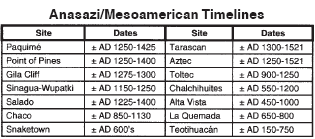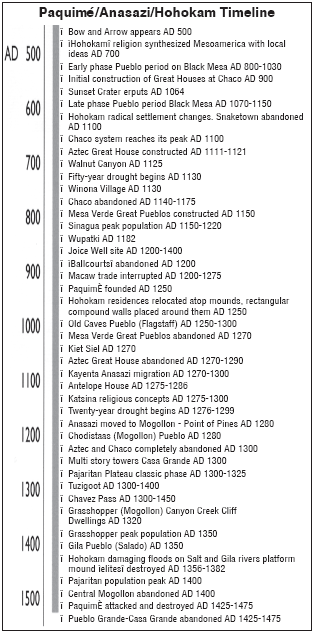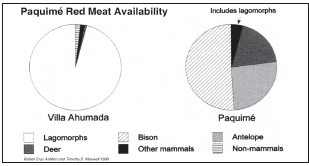 |
Paquimé was unique in that a high percentage of the bone recovered is from bison. Some archaeologists theorize that bison were found in the ambient environment. However, none of the other sites excavated throughout the region, as far as is known, has any substantial bison bone in evidence. Other sites pre-dating Paquimé also do not show any substantial assortment of bison bone. In fact, the large percentage of deer and antelope, while perhaps originating in a more localized environment, shows the ability of Paquimé to obtain large quantities of the most efficient and desirable sources of protein. This graph by Antillon and Maxwell (The Casas Grandes World, 1999) dramatically demonstrates that even other substantial Paquimé sites did not have access to bison. The House of the Well in central Paquimé shows |
||||
 |
|||||
 |
|||||
| evidence of two full bison and many birds that were sacrificed in this very unusual location where a substantial amount of “high status” copper artifacts imported from western Mexico have been found on the steps leading to the well (Charles DiPeso, Victoria Vargas and Christine S. VanPool). It is our hypothesis that, along with the very expensive Scarlet Macaws from southern Mexico, a large supply of corn from the Sierra Madre, the 2+ tons of shell from western Mexico, and the protein supply provided by Plains bison were imported to Paquimé for ceremonial reasons. This extensive trade network substantiates Paquimé’s wealth and power very dramatically. Anemia was the major debilitating disease found in the archaeological record throughout the Oasis America world. The archaeological record demonstrates that during the founding phases of any of the Oasis America city-states, the inhabitants were dining on deer, antelope, big horn sheep and, in the case of Paquimé, bison. In the final stages just prior to abandonment, the people were eating mice, rats, and rabbits to fulfill their red meat needs. Any population that was suffering from severe anemia would be at a severe competitive disadvantage with neighbors or invaders who were healthy. The Oasis America cultures had the option of adapting Mesoamerican dietary practices, and this phase of increased strife and warfare is now well documented in the archaeological record. At the beginning of the historic period, with Coronado’s expedition, all tribes north of Durango and Sinaloa had rejected this option. The Hopi and Zuni, though descendants of the Anasazi, were no longer the same cultural group. At Pueblo Grande, a major Hohokam site, a high carbohydrate and low protein diet caused a spike in female mortality during childbirth due to anemia, which produced a decline in fertility just before abandonment. Todd Boswick, Archaeologist-Pueblo Grande. |
|||||
copyright 2005 - Richard D Fisher - DigitalTeamWorks.com